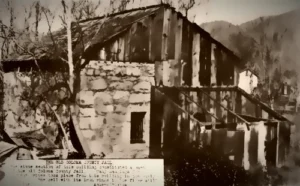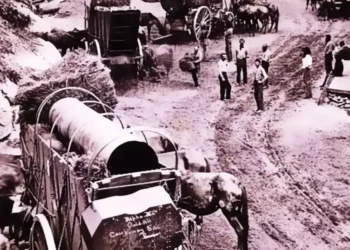By Cris Alarcon, InEDC Writer. (April 12, 2025) — Gold Rush Justice: My Walk Through the Forgotten Jails of El Dorado County.
Tales of swift justice and rugged law enforcement that characterized El Dorado County. The rapid influx of fortune seekers necessitated immediate measures to maintain order, leading to the establishment of makeshift jails.
I stood where the logs once stood—where justice was more bark than bite, and the scent of fresh-hewn pine hung thick in the air. Coloma, the birthplace of California’s Gold Rush, offered more than gold dust in riverbeds—it offered stories carved into stone and soaked in legend. As I wandered down High Street, I imagined the echo of boots on timber floors, the clank of chains, and the murmur of anxious miners who had let their tempers—or greed—get the better of them.
The first jail, built of logs, stood just around the corner. It must have looked like a tool shed to the hardened criminals and drunkards it was supposed to contain. By 1855, the Gold Rush’s chaos had outgrown such primitive quarters, and so the stone-block prison was erected in 1857, only to be shuttered by 1862—a mere five years later. Temporary, perhaps, but no less significant. It still stands, weathered but proud, a sentinel of an unruly past. Just a few steps away, a rusted metal cell from the Placerville courthouse rests like a ghost from a later chapter of justice (Marshall Gold Discovery SHP).
Over in Placerville—“Hangtown”, if you’re inclined to call it by its nickname—justice swift. At 305 Main Street, a sign marks the spot where the infamous Hangman’s Tree once stood. It wasn’t the only tree used for hangings, but it was certainly the most notorious. In 1849, three men were hanged for robbing a local store. The townsfolk didn’t bother with trials. They were more interested in sending messages—and they used rope instead of words.
But as the rush turned into a society, so too did the justice system evolve. In 1864, the county commissioned the Placerville Sandstone Jail, a Greek Revival edifice of carved permanence. With separate quarters for men and women, it was far more than a lock-up—it was a declaration of civil order. The historic 1864 sandstone jail in Placerville, California, was situated near the current location of the El Dorado County Jail at 300 Forni Road, Placerville, CA 95667. While the original sandstone structure no longer stands, this area remains central to the county’s law enforcement facilities today.
And within its walls, outlaws like Black Bart, the gentleman stagecoach robber, were said to have cooled their heels. Even whispers of the Dalton Gang—though harder to confirm—add another layer to the sandstone’s storied past (El Dorado County Jail History). The historic 1864 sandstone jail in Placerville, California, was situated near the current location of the El Dorado County Jail at 300 Forni Road, Placerville, CA 95667. While the original sandstone structure no longer stands, this area remains central to the county’s law enforcement facilities
But no legend haunts these foothills like that of Joaquin Murrieta. Was he a bandit? A freedom fighter? A Mexican Robin Hood exacting revenge after his brother was lynched? The stories vary—so do the spellings of his name—but one thing remains certain: Joaquin’s legacy is embedded in the soul of El Dorado. He was never captured alive, but his myth was embalmed in the history books.
As I stood in the doorway of the old jail, stone cooling my back and oak shading my face, I realized these weren’t just buildings. They were thresholds—between law and lawlessness, order and chaos, legend and truth. The ghosts of El Dorado County’s jails don’t rattle chains; they whisper stories… if you’re willing to listen.
Coloma’s Early Detention Facilities
Coloma, the epicenter of the Gold Rush, witnessed its first jail as a simple log structure on High Street. As the town burgeoned, a more substantial stone-block prison was constructed in 1857, serving until 1862. Today, remnants of this facility stand as silent witnesses to a bygone era, with a metal cell from the Placerville courthouse nearby, symbolizing the evolution of the justice system. Western Mining History

Placerville’s “Hangtown” Era
Placerville, once known as “Hangtown,” earned its moniker from the swift execution of justice, notably the hanging of three men in 1849 for robbery. The infamous Hangman’s Tree, located at 305 Main Street, became emblematic of the town’s approach to law and order. While the original tree no longer stands, the site remains a poignant reminder of the town’s tumultuous past.
The 1864 Sandstone Jail
Recognizing the need for a formal detention facility, El Dorado County constructed a sandstone jail in Placerville in 1864. Designed in the Greek Revival style, it housed both male and female inmates and bore witness to numerous trials and executions. Notable inmates included outlaws like Black Bart, who operated in the Sierra Nevada region during the 1870s, and members of the Dalton Gang, notorious for their bank and stagecoach robberies in the late 19th century.
Corrected Statement:
While Black Bart (real name: Charles E. Boles), the infamous gentleman stagecoach robber, did operate extensively in Northern California and the Sierra Nevada region, there is no verifiable historical evidence that he was ever incarcerated in the 1864 Placerville Sandstone Jail. Similarly, members of the Dalton Gang, who were active mostly in Kansas, Oklahoma, and Indian Territory, were not known to have been held in El Dorado County.
While the sandstone jail in Placerville housed its share of rough characters, there are no verified records confirming that outlaws like Black Bart or the Dalton Gang were held there. However, the jail remains a powerful symbol of frontier justice during a time when outlaws and vigilantes roamed the Sierra foothills.
Legends of Joaquin Murrieta
Joaquin Murrieta, often referred to as the “Robin Hood of El Dorado,” is a legendary figure associated with the region. Though historical records are sparse, tales of his exploits during the Gold Rush era have become integral to local folklore. His story embodies the complexities of justice and rebellion during a time when the line between hero and outlaw was often blurred.
These narratives of El Dorado County’s frontier jails and the figures associated with them offer a window into a period marked by rapid change, lawlessness, and the relentless pursuit of justice. They serve as enduring reminders of the challenges faced and the resilience demonstrated during California’s formative years.
Preserving the Past
Today, remnants of these early jails and stories continue to captivate residents and visitors alike. The preservation of these sites offers a tangible connection to El Dorado County’s formative years and its enduring legacy.
For more information on El Dorado County’s history, visit the El Dorado County Historical Museum or explore local archives.










